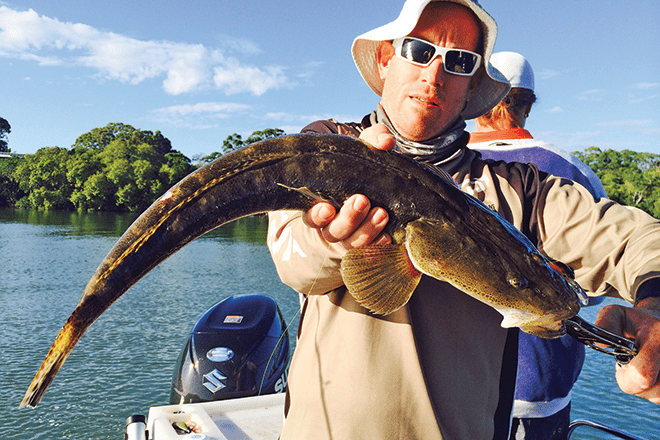UNFORTUNATELY, prior to writing this article, ex-cyclone Debbie came down and pretty much flooded most of southeast Queensland.
The ongoing effect is the Logan River is pumping out millions and millions of litres of brown filthy water into southern Moreton Bay. With a bit of luck, by the time you read this the water will have cleaned up a bit and we will be back into the fishing, so I will go over what was happening before Debbie and what we might expect after the water cleans up.
Before the rain, we weren’t breaking any records but were catching squire/snapper in southern Moreton Bay as well as a few flathead, bream and trevally. The best technique for flathead and bream was trolling small hard-body lures over the same area time and time again to annoy the fish into an aggressive strike. For snapper, continually casting with soft plastics or drifting with lightly weighted fresh bait was the most effective way to get a bite. When targeting bream and flathead, the best times to be chasing them are on either the low tide, working around the drains and drop-offs, or on the high tide, fishing the mangrove lines. Trolling speed should be as slow as you can go.
When chasing snapper, I found working rubble grounds and structure on the mid to high tides returned the best results. Last month I gave you a little run-down on flathead techniques, so this month I’ll talk about snapper tactics. Let’s start with the rod and reel setup. I like a 3-6kg rod and 3000-size spin reel spooled with 10-15lb braid and 12-15lb leader. When it comes to jig head weight, I will use anything from 1/8oz to 3/8oz depending on the amount of current and a 3/0 or 4/0 hook. Mustad Darter jig heads are perfect for this.
I’ve also been using an array of soft plastics from Zerek Live Flash Minnow Wrigglies and Zerek Live Shrimp Hot Legs to Gobblers Paddle Tails and Curl Grubs and all have been working well when paired with Darter jig heads. No matter what soft plastics and gear you are using or whether you’re casting forward, to the side or behind the vessel, when chasing snapper, make sure your soft plastic gets to the bottom. When you make your lifts, ensure you pause and wait for your plastic to get back to the bottom.
In shallower water, these fish will be hugging the bottom, especially in a lot of current because they will push to the bottom to avoid using too much energy in trying to fight the current. Make sure you use enough weight to get your plastic down to where the fish are sitting, otherwise known as the strike zone.
When looking for rubble ground and structure, find where the current runs pretty hard. A lot of the time, the current will have swept the mud and silt away, exposing the rock underneath. Over time and with the right water conditions, soft corals, mussels and other organisms start to grow, making a really good food source for our Moreton Bay snapper. If you would like to learn more about this, we conduct a few night courses where we go over moon phases, how to find the ground and much more information about bay snapper, flathead and many other species. All you have to do is give me a ring and I will give you all the information you need to help you catch more fish as well as that trophy fish you’ve been looking for.
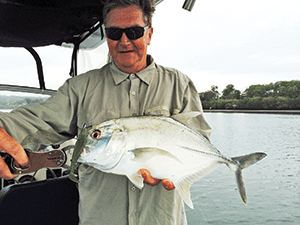

hit a Zerek Bulldog Crank.
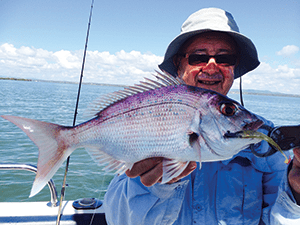

Shrimp Hot Legs.
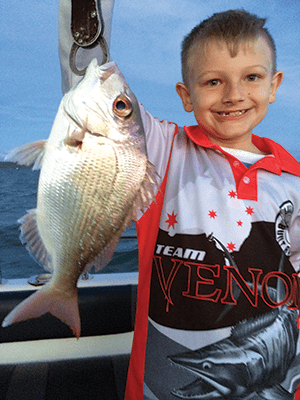
ground, not all the fish will be keepers, but this is an easy way for the kids to catch a few fish.
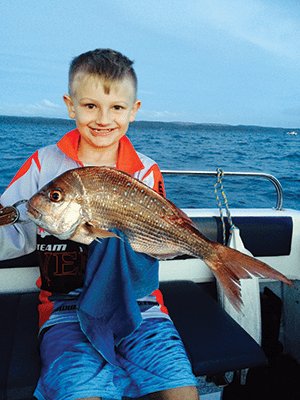
snapper on a lightly weighted fresh herring
while drifting the rubble grounds.
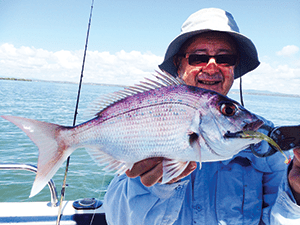
So what can we expect after these floods? Well I feel it could be late April or the start of May before it really cleans up, so with a bit of luck the water will be clear for the start of our flathead, bream and winter snapper seasons. We might even see the start of the winter whiting season. The bay will be full of nutrients pushed out of the rivers so that may help fire up the fish. I hope that by the time my next article is due I will have been out there and be able to give you a run-down of what we found after the floods.
Anyway, stay safe on the water, and if you can’t go fishing because the water quality is too bad, why not think about one of our off-water courses to sharpen up on a few of those techniques you may have forgotten and absorb valuable new information. There is always something you didn’t know and even I am always learning when out on the water. Until next month, stay safe. If you’d like to join me on a charter, phone 0433 732 310, check out moretonbaycharters.com.au or visit the Moreton Bay Charters Facebook page. If you would like to know more about our night tuition classes, feel free to give me a call.
 Bush ‘n Beach Fishing Magazine Location reports & tips for fishing, boating, camping, kayaking, 4WDing in Queensland and Northern NSW
Bush ‘n Beach Fishing Magazine Location reports & tips for fishing, boating, camping, kayaking, 4WDing in Queensland and Northern NSW

